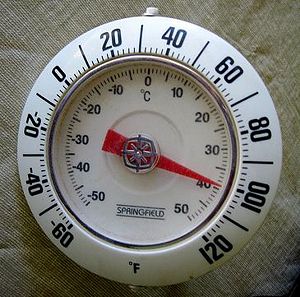Temperature conversion: Difference between revisions
imported>Mark Widmer m (Grammar cleanup) |
mNo edit summary |
||
| Line 59: | Line 59: | ||
|'''Kelvin'''||°R = 1.8 × K||K = °R ÷ 1.8 | |'''Kelvin'''||°R = 1.8 × K||K = °R ÷ 1.8 | ||
|} | |} | ||
[[Category:Suggestion Bot Tag]] | |||
Latest revision as of 16:00, 25 October 2024
Temperature, like many quantities, can be measured in different units, many of which have particular uses. Temperature conversion refers to the process of transforming values measured in one unit to values in another unit. The most widely used scales are those of Kelvin, Celsius, Fahrenheit and Rankine, for which conversion tables are provided below.
Table 1 compares the values for three major reference points in the Kelvin, Celsius, Fahrenheit and Rankine temperature scales.
| Reference points | Kelvin | Celsius | Fahrenheit | Rankine |
|---|---|---|---|---|
| Absolute zero | 0 K | −273.15 °C | −459.67 °F | 0 °R |
| Melting point of water (a) | 273.15 K | 0 °C | 32 °F | 491.67 °R |
| Normal boiling point of water (b) | 373.15 K | 100 °C | 212 °F | 671.67 °R |
| (a) The melting point of water (i.e., ice) used to be defined as 0°C (32°F) under an atmospheric pressure of 101.325 kPa. 0°C is taken to be 273.15 K but does not exactly equal the melting point of water, which is now defined as 273.152519 K. Note that the freezing point of water is ill-defined as water usually freezes a few degrees below 0°C and the actual temperature is not reproducible.
(b) The normal boiling point of water used to be defined as 100°C at an atmospheric pressure of 101.325 kPa, but it has now been estimated at 99.9839°C. | ||||
Table 2 presents the factors required to convert temperatures from any one of those four scales to the other three.
| Scale | To Kelvin | From Kelvin |
|---|---|---|
| Celsius | K = °C + 273.15 | °C = K − 273.15 |
| Fahrenheit | K = (°F + 459.67) ÷ 1.8 | °F = (K × 1.8) − 459.67 |
| Rankine | K = °R ÷ 1.8 | °R = 1.8 × K |
| Scale | To Fahrenheit | From Fahrenheit |
| Celsius | °F = (1.8 × °C) + 32 | °C = (°F − 32) ÷ 1.8 |
| Rankine | °F = °R − 459.67 | °R = °F + 459.67 |
| Kelvin | °F = (1.8 × K) − 459.67 | K = (°F + 459.67) ÷ 1.8 |
| Scale | To Celsius | From Celsius |
| Fahrenheit | °C = (°F − 32) ÷ 1.8 | °F = (1.8 × °C) + 32 |
| Rankine | °C = (°R ÷ 1.8) − 273.15 | °R = 1.8 × (°C + 273.15) |
| Kelvin | °C = K − 273.15 | K = °C + 273.15 |
| Scale | To Rankine | From Rankine |
| Celsius | °R = 1.8 × (°C + 273.15) | °C = (°R ÷ 1.8) − 273.15 |
| Fahrenheit | °R = °F + 459.67 | °F = °R − 459.67 |
| Kelvin | °R = 1.8 × K | K = °R ÷ 1.8 |
